| dc.contributor.advisor | Ed Boyden. | en_US |
| dc.contributor.author | Suk, Ho-Jun. | en_US |
| dc.contributor.other | Harvard--MIT Program in Health Sciences and Technology. | en_US |
| dc.date.accessioned | 2019-10-04T21:34:06Z | |
| dc.date.available | 2019-10-04T21:34:06Z | |
| dc.date.copyright | 2019 | en_US |
| dc.date.issued | 2019 | en_US |
| dc.identifier.uri | https://hdl.handle.net/1721.1/122429 | |
| dc.description | Thesis: Ph. D., Harvard-MIT Program in Health Sciences and Technology, 2019 | en_US |
| dc.description | Cataloged from student-submitted PDF version of thesis. | en_US |
| dc.description | Includes bibliographical references (pages 105-110). | en_US |
| dc.description.abstract | Targeted patch clamp recording is a powerful method for characterizing visually identified cells in intact neural circuits, but it requires skill to perform. We found that a closed-loop real-time imaging strategy, which continuously compensates for cell movement while approaching the cell with a pipette tip, allows for the development of an algorithm amenable to automation. We built a robotic system that can implement this algorithm and validated that our system can automatically patch fluorophore-expressing neurons of multiple types in the living mouse cortex, with yields comparable to skilled human experimenters. By facilitating targeted patch clamp recordings in vivo, our robot may enable scalable characterization of identified cell types in intact neural circuits. Activities of individual neurons in neural circuits give rise to network oscillations, whose frequencies are closely related to specific brain states. | en_US |
| dc.description.abstract | For example, network oscillations in the 30 - 90 Hz range, observed using electroencephalogram (EEG), are called gamma oscillations and increase during attention, memory formation, and recall. In Alzheimer's disease (AD), gamma oscillations are disrupted compared to healthy individuals. Recently, noninvasive visual and auditory stimulations at 40 Hz, called Gamma ENtrainment Using Sensory stimulus ("GENUS"), have been shown to positively impact pathology and improve memory in AD mouse models, with concurrent visual and auditory GENUS leading to a more widespread effect in the AD mouse brain compared to visual or auditory stimulation alone. However, it is unclear what effect such sensory stimulations would have on the human brain. To test for the safety and feasibility of GENUS in humans, we developed a device that can deliver 40 Hz light and sound stimulations at intensity levels tolerable to humans. | en_US |
| dc.description.abstract | We found that our device can safely lead to steady 40 Hz entrainment in cognitively normal young (20 - 33 years old) and older (55 - 75 years old) subjects, with concurrent visual and auditory stimulation leading to stronger and more widespread entrainment than visual or auditory stimulation alone. These findings suggest that GENUS can be a safe and effective method for widespread 40 Hz entrainment, which may have therapeutic effects in people suffering from AD. | en_US |
| dc.description.statementofresponsibility | by Ho-Jun Suk. | en_US |
| dc.format.extent | 110 pages | en_US |
| dc.language.iso | eng | en_US |
| dc.publisher | Massachusetts Institute of Technology | en_US |
| dc.rights | MIT theses are protected by copyright. They may be viewed, downloaded, or printed from this source but further reproduction or distribution in any format is prohibited without written permission. | en_US |
| dc.rights.uri | http://dspace.mit.edu/handle/1721.1/7582 | en_US |
| dc.subject | Harvard--MIT Program in Health Sciences and Technology. | en_US |
| dc.title | Automated cell-targeted electrophysiology in vivo and non-invasive gamma frequency entrainment | en_US |
| dc.type | Thesis | en_US |
| dc.description.degree | Ph. D. | en_US |
| dc.contributor.department | Harvard--MIT Program in Health Sciences and Technology | en_US |
| dc.contributor.department | Harvard University--MIT Division of Health Sciences and Technology | |
| dc.identifier.oclc | 1120128929 | en_US |
| dc.description.collection | Ph.D. Harvard-MIT Program in Health Sciences and Technology | en_US |
| dspace.imported | 2019-10-04T21:34:05Z | en_US |
| mit.thesis.degree | Doctoral | en_US |
| mit.thesis.department | HST | en_US |
